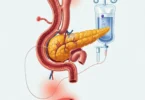The basal cell carcinoma (BCC) is a type of white skin cancer and also known as basal cell Skin cancer. Bcc is most common form of skin cancer. It develops from the so-called basal cells at the base of the epidermis. Initially formed a nodule or induration in to the affected area of skin . It tends to occur in areas which are exposed to a stronger sunlight. Accordingly, in 80% of cases basal cell carcinoma found at the head and neck. Rarely tumor growth is induced by arsenic or long-term use of medication which suppress the immune system. The average age of patients is 60 years in central europe. In recent years, however, younger patients are increasingly observed with basal cell carcinoma.
Without treatment, the basal cell carcinoma grows on locally and it can destroy cartilage and bone. Since it forms secondary tumors (extremely rare metastases ) in the body, it is considered a semi-malignant.
Basal Cell Carcinoma: Frequency
The basal cell carcinoma (bcc) preferably occurs in older age on (average age: 60 years). Due to the changing leisure behavior (eg visiting solariums or travel in areas with strong sunlight) younger people are increasingly affected by basal cell carcinoma.
Blonde or redhead, fair-skinned people with blue eyes , that slightly get a sunburn (so-called celtic skin type), are among the main risk groups for basal cell carcinoma. Also, people who work outdoors or who expose to intensive UV radiation for other reasons are particularly vulnerable to basal cell carcinoma and squamous cell carcinoma of the skin ( collectively known as white or light skin cancer).
A basal cell carcinoma typically develops on the body that are particularly exposed to strong light: in 80 percent of cases, the basal cell carcinoma therefore affects the face , head (bald) and neck .
In the fair-skinned population the basal cell carcinoma is the most common malignant skin tumor.
Forms of basal cell carcinoma
Clinically and histological, basal cell carcinoma has following forms:
Solid nodular basal cell carcinoma : which is often reflected by the nose, the eyes internal angles and around the mouth in the face. Typical is a glassy nodules with enlarged veins (telangiectasia)
Superficial-multicentric basal cell carcinoma: often occurs on the trunk, appear as a reddish, scaly body.
Pigmented basal cell carcinoma: basal cell carcinomas often form melanin and can represent blackish.
Scar like basal cell carcinoma: it grows scar-like and are poorly distinguished from the healthy tissues. The surgery usually takes more time to reach a safe distance.
Ulcerated growing basal cell carcinoma ( rodent ulcer ): tumor with spider shape nodular zone and telangiectasia which spreads to the skin surface, but do not grow into deeper tissue layers.
Destructively growing basal cell carcinoma (ulcus terebrans) : this grows in depth and destroys cartilage and bone, as well as blood vessels, nerves and tear ducts. This basal cell carcinomas often occur at the embryonic fusion lines at which the body segments have grown together. These lines are for example the eye angle and nasolabial.
Basal Cell Carcinoma: Causes
Long term exposure to intense sunlight is one of the most common cause of basel cell carcinoma . Bccs occur predominantly in skin areas of the head and neck, because these parts of the body are most exposed to the sun. Those areas which are protected with clothing are rarely affected by UV radiations.
Excessive UV radiation damages the genetic material ( DNA) of the cells. Usually the affected cells die. However, if damage dna is left behind in surviving cells, it can lead to the formation of a basal cell carcinoma. In addition, excessive UV radiations weaken the immune system, so that there is interference in the body’s defenses and this can favor the formation of a basal cell carcinoma.
The genetic predisposition is also an important risk factor for basal cell carcinoma. In rare cases, external influences such carcinogenic substances e.g. Arsenic (used to treat psoriasis) are responsible for BCC.
In some cases, light skin cancer develops in connection with certain skin diseases such as:
- Albinism
- Superficial basal cell carcinoma or
- Xeroderma pigmentosum (moonlight disease)
- Hypersensitivity to light
- Tendency to sun allergy
Basal Cell Carcinoma: Symptoms
Typical sign of a basal cell carcinoma are very fine red veins (known telangiectasias) on the edge of the tumor. Sometimes the light skin cancer is similar to an inflammatory skin disease like psoriasis. Basal cell carcinomas often begin as small, flat nodules that have a glossy skin surface and are covered with broken capillaries. It can bleed after slight mechanical irritation of the tumor. On the trunk, basal cell carcinomas often appear as sharply demarcated red, sometimes scaly patches, which are barely palpable.
The following symptoms may occur:
- A reddish, nodular, pearly lesion with dilated vessels, called telangiectasia and occasionally a central crust.
- A rough, scar-like hardening with a crusty bearing
- A nodule that does not heal by itself
- A reddish, sometimes painful area that bleeds sometimes slightly
Basal Cell Carcinoma: Diagnosis
Basal cell carcinoma (BCC) have visible lesion so doctor can make the diagnosis even with the naked eye (view diagnosis). The definite diagnosis of basal cell carcinoma is based on the microscopic histological examination (biopsy). In addition, the dermatologist can also use photodynamic therapy (PDT) as an adjunct to basal cell carcinoma diagnosis. PDT can detect how far a basal cell carcinoma expands in the skin. In order to determine the spread of the skin tumor, the affected skin area and its vicinity is treated with a special cream. Then the tumor cells can be made visible with a special lamp in a dark room.
Basal Cell Carcinoma: Treatments
A basal cell carcinoma (BCC) requires a therapy to prevent the continues growth of tumor and thereby protect the healthy tissue. For basal cell carcinomas (white or light skin cancer ), there are several treatment options, which depends on …
- Which type of BCC are exists,
- Where the tumor is located,
- How big the basal cell carcinoma is
- How far it has already spread,
- How old is the person and what is general condition of person.
The best results can be achieved with the complete surgical removal of the basal cell carcinoma.
Surgery
Most commonly, the treatment is performed by an operation in which affected skin is cut off and is then examined histologically. This histological examination is carried out carefully and in particular with larger pre-operated basal cell carcinoma, as well as in problem localization area such as in skin folds and around the eyes. The dermatologist removed basal cell carcinoma usually under local anesthesia in an operation. The operation therapy takes place in two steps .
In a first operation, the surgeon removes the tumor with a safety margin of a few millimeters. The edges of the removed skin is then examined under a microscope. If they are not tumor-free, in a second step a more skin around the bcc is removed to make it tumor fee. This surgical procedure can be advantageous, even for small basal cell carcinomas. It preserves as much healthy skin and is safe because it helps to treat defective cells that were not visible on the surface.
Other treatments options are:
- The freezing with liquid nitrogen (cryosurgery)
- Radiotherapy with x-ray irradiation surface
- Local chemotherapy with an applied skin cytostatic
- The superficial scraping with a sharp spoon (curettage, shaveexzision)
- The cream treatment with the originally developed for the treatment of warts imiquimod
- Photodynamic therapy using visible light
Basal Cell Carcinoma: Prevention
White skin cancers such as basal cell carcinoma is a cancer , which can often be prevented:
Protect your skin and children from intense sunlight and sunburn . Use sunscreens with a high sun protection factors. Likewise, it is advisable to wear a hat with a wide brim in strong sunlight. Those people which are potentially vulnerable to basal cell carcinoma (due to light skin type and genetic predisposition) should regularly examine themselves.
For more general information about cancer please visit these links:







